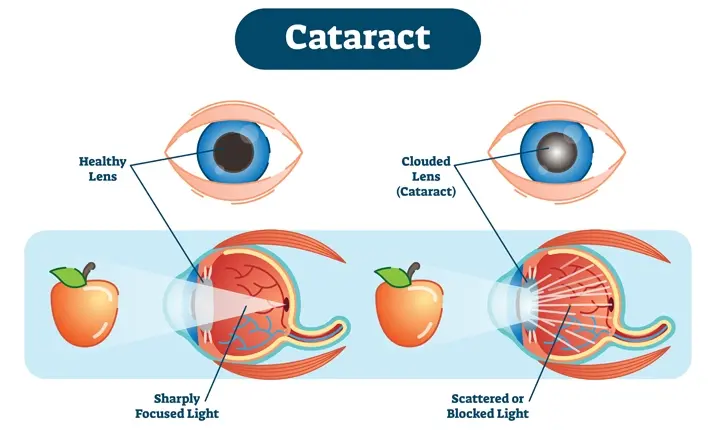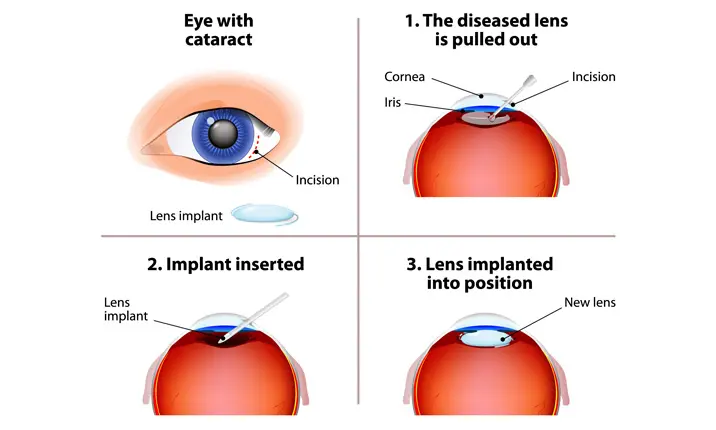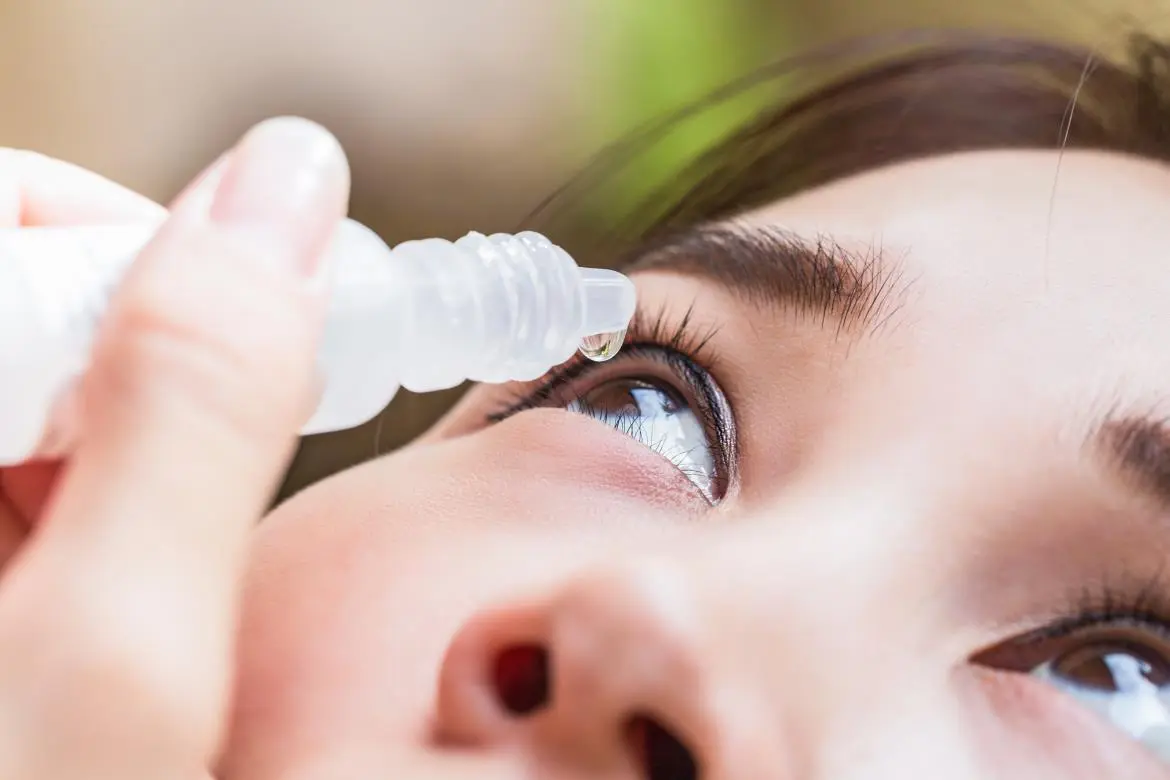

Source: Shutterstock
All You Need to Know about Cataract Surgery
Last updated: Thursday, October 18, 2018 | 4 min reading time
Dr Loh Boon Kwang, ophthalmologist at Mount Elizabeth Novena Hospital, tells us why we should not delay treatment for cataracts, and the types of surgery available to help regain your vision.
It's likely you know of a parent or family member who has cataract or has undergone cataract surgery. That's not surprising, given that in Singapore, cataract affects around 80% of the population above 60 years old and 95% of the population above 70. In fact, more than 30% of people aged 45 and above have some degree of cataract.
The presence of other health issues, such as severe myopia, smoking, high blood pressure and diabetes, can also increase your risk of cataracts. Although the reasons are still not fully understood, people with diabetes mellitus statistically face a 60% higher risk of developing cataracts.
What are cataracts?
Cataracts are the clouding of the normally clear lens of the eyes. In the early stages, only a small part of the eye's lens is usually affected and therefore there may be no notable vision loss. As the cataract clouds more of the lens and distorts the light passing through the it, changes to the eyesight appear.
What causes cataracts?
Most cataracts are due to ageing or injury in the tissue that makes up the eye lens.
They may also be a result of certain inherited genetic disorders, other eye conditions, past eye surgery or medical conditions such as diabetes.
Long-term use of steroid medications can also cause the development of cataracts.
Signs and symptoms of cataracts
Cataracts can develop at any age, even if you are not at high risk for it. Look out for these symptoms and consult an eye specialist to get a diagnosis, just to be safe:
- You have blurry or cloudy vision, and things appear hazy all the time.
- You suffer from poor night vision. You may start to see halos around lights, which in turn makes activities, such as driving at night, challenging.
- You develop greater sensitivity to bright lights, which hurts your eyes.
- You see 2 images of a single object. Also known as diplopia, double vision can affect your balance, movement and reading ability.
- Over time, your vision may acquire a brown or yellow tinge, and this can affect your ability to tell the difference between certain colours.
The good news is cataract surgery is very common and is generally a safe procedure. Artificial lens implants such as multifocal and other lenses will be able to correct short-sightedness and long-sightedness, as well astigmatism and presbyopia, at the same time. If you are suitable for multifocal lens, you can possibly say goodbye to spectacles and go about your daily activities with near perfect vision.
An early diagnosis and timely treatment of cataract will be able to prevent the condition from worsening.
Delayed treatment may come at a time when the lens is more unstable, and when there are other complications such as glaucoma. Delayed surgery also comes with increased risk of complications, reduced success rate of the operation, and a longer recovery process with less favourable results, as compared to treating the condition early.
Types of cataract surgery
There are 2 main types of surgical procedures to treat cataracts.
1. Phacoemulsification cataract surgery
The procedure starts off with you being slightly sedated: mild sedation is applied by an anaesthetist so you don't feel anything. Once this is done, the doctor proceeds to make a small incision at the edge of the cornea to enter the eye. They will break up the cataract using ultrasound and remove the cataract. An artificial lens will then be implanted to restore your sight. No stitches are required as the wound often seals on its own.
The entire process takes about 30 – 45 minutes and is treated as a day case so you need not stay overnight.
After surgery, you'll need to apply medicated eye drops to improve recovery and prevent infection. Your eye will usually heal thoroughly after a month.
Phacoemulsification is the standard cataract surgery procedure and has a 95% success rate. This is still the procedure of choice and is suitable for most patients.
2. Laser-assisted cataract surgery
This is similar to phacoemulsification surgery where ultrasound energy is used to break up the cataract. The difference is that laser is used to replace certain steps of the procedure. Laser-assisted cataract surgery uses a femtosecond laser to remove cataracts accurately and precisely, replacing the use of handmade incisions.
What are the risks of cataract surgery?
Cataract surgery is generally safe but as with any other surgery, it carries a risk of infection and bleeding.
There is also a risk of retinal detachment with the surgery. This happens when the retina, which sits all the way back in the eye pulls away from its position. Signs of retinal detachment include:
- Feeling like a curtain has fallen away over part of your eye
- Having new floating spots in your vision
- Seeing flashes of light
See your doctor immediately if you notice any of these signs.
Tips for post cataract surgery
Recovery from a cataract surgery is usually short and uneventful. You may find yourself easily resuming your usual activities within a day after the surgery. However, you should take extra care especially during the first week of surgery. Here are some tips you can observe to get the best recovery and prevent future complications:
- Immediately after the procedure, avoid bending over so that you don't put extra pressure on your eye
- If possible, don't sneeze or vomit right after surgery
- Don't drive on the first day following surgery
- Take the prescribed antibiotic and anti-inflammatory eye drops to prevent infections
- Don't lift anything heavy or perform strenuous activities for a few weeks
- Be careful when walking around to avoid bumping into doors or other objects
- Avoid swimming or using a hot tub during the first week of surgery to avoid infection
- Don't expose your eye to irritant such as dust, dirt, wind and pollen during the first few weeks of surgery
- Don't rub your eye after surgery
There is currently not enough evidence to determine if laser-assisted cataract surgery or standard cataract surgery will result in better outcome, as it will depend on your eye condition. You should discuss with your eye specialist to decide which surgery method is more suitable for your eyes.
Fix your cataract at Mount Elizabeth for $0
Cataract is the most common cause of blindness in the world, and surgery is the only method to treat it. With an Integrated Shield Plan and a full rider* that covers private hospitals, you may be fully covered for treatment at Mount Elizabeth Hospitals.
Integrated Shield Plans are on top of the basic MediShield Life plan, and provide additional coverage for Class B1 and A wards, even for private hospitals such as Mount Elizabeth. A full rider completely covers all co-insurance and deductible components of the bill.
What this means is that with both an [Integrated Shield Plan] and a full rider, you won't have to pay cash for your [cataract surgery] as it will be fully covered.
If your full rider is purchased after 8 March 2018, you'll still enjoy full coverage on co-insurance and deductible until 1 April 2021. After this date, a 5% co-payment will apply.
Fixed priced packages are available at Mount Elizabeth Hospitals so you'll know exactly what to expect. Call +65 9834 0999, WhatsApp +65 9834 0999, or email askme@parkwaypantai.com to find out if your insurance plan covers you for Mount Elizabeth Hospitals.
*Terms and conditions apply. Valid for full riders purchased before 1 April 2019. For more information, visit checkmyhealthcoverage.sg or contact the numbers listed above.
Prevalence, Risk Factors, and Impact of Undiagnosed Visually Significant Cataract: The Singapore Epidemiology of Eye Diseases Study. Retrieved on 1 Oct 2018 from https://www.ncbi.nlm.nih.gov/pmc/articles/PMC5271362/
What is cataract? Retrieved 30 May 2018 from https://www.healthline.com/health/cataract
Vision Changes Related to Cataracts. Retrieved on 04 October 2018 from http://www.visionaware.org/info/your-eye-condition/cataracts/vision-changes-related-to-cataracts/125
Cataracts in Diabetic Patients: A Review Article. Retrieved on 04 October 2018 from https://www.ncbi.nlm.nih.gov/pmc/articles/PMC3589218/
Cataracts and Diabetes. Retrieved on 04 October 2018 from https://www.diabetes.co.uk/diabetes-complications/cataracts.html
Cataract Surgery. Retrieved on 04 October 2018 from https://www.mayoclinic.org/tests-procedures/cataract-surgery/about/pac-20384765
Femtosecond Laser-Assisted Cataract Surgery. Retrieved on 04 October 2018 from https://www.snec.com.sg/eye-conditions-and-treatments/common-eye-conditions-and-procedures/Pages/femtosecond-laser.aspx
Phacoemulsification for cataracts. Retrieved on 04 October 2018 from https://www.surgeryencyclopedia.com/Pa-St/Phacoemulsification-for-Cataracts.html
Laser-Assisted Cataract Surgery. Retrieved on 04 October 2018 from http://yoursightmatters.com/cataracts/laser-assisted-cataract-surgery/
Cataracts (2018, June 23) Retrieved December 28, 2020, from https://www.mayoclinic.org/diseases-conditions/cataracts/diagnosis-treatment/drc-20353795
How Can Cataract Surgery Cause Retinal Detachment? (2020, July 12) Retrieved December 28, 2020, from https://www.webmd.com/eye-health/cataracts/qa/how-can-cataract-surgery-cause-retinal-detachment
Cataract Surgery Recovery: 8 Tips to Minimize Recovery Time (2019, July) Retrieved December 28, 2020, from https://www.allaboutvision.com/conditions/cataract-surgery-recovery.htm
What is cataract? Retrieved 30 May 2018 from https://www.healthline.com/health/cataract
Vision Changes Related to Cataracts. Retrieved on 04 October 2018 from http://www.visionaware.org/info/your-eye-condition/cataracts/vision-changes-related-to-cataracts/125
Cataracts in Diabetic Patients: A Review Article. Retrieved on 04 October 2018 from https://www.ncbi.nlm.nih.gov/pmc/articles/PMC3589218/
Cataracts and Diabetes. Retrieved on 04 October 2018 from https://www.diabetes.co.uk/diabetes-complications/cataracts.html
Cataract Surgery. Retrieved on 04 October 2018 from https://www.mayoclinic.org/tests-procedures/cataract-surgery/about/pac-20384765
Femtosecond Laser-Assisted Cataract Surgery. Retrieved on 04 October 2018 from https://www.snec.com.sg/eye-conditions-and-treatments/common-eye-conditions-and-procedures/Pages/femtosecond-laser.aspx
Phacoemulsification for cataracts. Retrieved on 04 October 2018 from https://www.surgeryencyclopedia.com/Pa-St/Phacoemulsification-for-Cataracts.html
Laser-Assisted Cataract Surgery. Retrieved on 04 October 2018 from http://yoursightmatters.com/cataracts/laser-assisted-cataract-surgery/
Cataracts (2018, June 23) Retrieved December 28, 2020, from https://www.mayoclinic.org/diseases-conditions/cataracts/diagnosis-treatment/drc-20353795
How Can Cataract Surgery Cause Retinal Detachment? (2020, July 12) Retrieved December 28, 2020, from https://www.webmd.com/eye-health/cataracts/qa/how-can-cataract-surgery-cause-retinal-detachment
Cataract Surgery Recovery: 8 Tips to Minimize Recovery Time (2019, July) Retrieved December 28, 2020, from https://www.allaboutvision.com/conditions/cataract-surgery-recovery.htm
 Brain & Spine Care
Brain & Spine Care










